Integrating NDVI-Based Within-Wetland Vegetation Classification in a Land Surface Model Improves Methane Emission Estimations
Abstract
1. Introduction
2. Materials and Methods
2.1. NDVI-Based Classification Overview
2.2. US-LA3 Wetland
2.3. Classification of the Reference Patch-Types at the US-LA3 Site
2.4. Seasonal NDVI Timeseries-Based Classification of Patch-Types at US-LA3 from HLS
2.5. ELM Overview and Simulation Set-Up
2.6. Field Data
3. Results
3.1. US-LA3 Classification
3.2. ELM Results
4. Discussion
HLS-Classification Uncertainty and Its on Impact Simulated Methane Flux
5. Conclusions
Author Contributions
Funding
Data Availability Statement
Acknowledgments
Conflicts of Interest
References
- Forster, P.; Storelvmo, T.; Armour, K.; Collins, W.; Dufresne, J.-L.; Frame, D.; Lunt, D.J.; Mauritsen, T.; Palmer, M.D.; Watanabe, M.; et al. The Earth’s Energy Budget, Climate Feedbacks, and Climate Sensitivity. In Climate Change 2021: The Physical Science Basis. Contribution of Working Group I to the Sixth Assessment Report of the Intergovernmental Panel on Climate Change; Cambridge University Press: Cambridge, UK; New York, NY, USA, 2021; pp. 923–1054. ISBN 9781009157896. [Google Scholar]
- Riley, W.J.; Subin, Z.M.; Lawrence, D.M.; Swenson, S.C.; Torn, M.S.; Meng, L.; Mahowald, N.M.; Hess, P. Barriers to Predicting Changes in Global Terrestrial Methane Fluxes: Analyses Using CLM4Me, a Methane Biogeochemistry Model Integrated in CESM. Biogeosciences 2011, 8, 1925–1953. [Google Scholar] [CrossRef]
- Saunois, M.; Stavert, A.R.; Poulter, B.; Bousquet, P.; Canadell, J.G.; Jackson, R.B.; Raymond, P.A.; Dlugokencky, E.J.; Houweling, S.; Patra, P.K.; et al. The Global Methane Budget 2000–2017. Earth Syst. Sci. Data 2020, 12, 1561–1623. [Google Scholar] [CrossRef]
- Saunois, M.; Bousquet, P.; Poulter, B.; Peregon, A.; Ciais, P.; Canadell, J.G.; Dlugokencky, E.J.; Etiope, G.; Bastviken, D.; Houweling, S.; et al. Variability and Quasi-Decadal Changes in the Methane Budget over the Period 2000-2012. Atmos. Chem. Phys. 2017, 17, 11135–11161. [Google Scholar] [CrossRef]
- Villa, J.A.; Ju, Y.; Yazbeck, T.; Waldo, S.; Wrighton, K.C.; Bohrer, G. Ebullition Dominates Methane Fluxes from the Water Surface across Different Ecohydrological Patches in a Temperate Freshwater Marsh at the End of the Growing Season. Sci. Total Environ. 2021, 767, 144498. [Google Scholar] [CrossRef]
- Ge, M.; Korrensalo, A.; Laiho, R.; Lohila, A.; Makiranta, P.; Pihlatie, M.; Tuittila, E.-S.; Kohl, L.; Putkinen, A.; Koskinen, M. Plant Phenology and Species-Specific Traits Control Plant CH4 Emissions in a Northern Boreal Fen. New Phytol. 2023, 238, 1019–1032. [Google Scholar] [CrossRef] [PubMed]
- Jeffrey, L.C.; Maher, D.T.; Johnston, S.G.; Kelaher, B.P.; Steven, A.; Tait, D.R. Wetland Methane Emissions Dominated by Plant-Mediated Fluxes: Contrasting Emissions Pathways and Seasons within a Shallow Freshwater Subtropical Wetland. Limnol. Oceanogr. 2019, 64, 1895–1912. [Google Scholar] [CrossRef]
- Flato, G.M. Earth System Models: An Overview. Wiley Interdiscip. Rev. Clim. Chang. 2011, 2, 783–800. [Google Scholar] [CrossRef]
- LaFond-Hudson, S.; Sulman, B. Modeling Strategies and Data Needs for Representing Coastal Wetland Vegetation in Land Surface Models. New Phytol. 2023, 238, 938–951. [Google Scholar] [CrossRef]
- Ju, Y.; Bohrer, G. Classification of Wetland Vegetation Based on NDVI Timeseries from HLS Dataset. Remote Sens. 2022, 14, 2107. [Google Scholar] [CrossRef]
- Adam, E.; Mutanga, O.; Rugege, D. Multispectral and Hyperspectral Remote Sensing for Identification and Mapping of Wetland Vegetation: A Review. Wetl. Ecol. Manag. 2010, 18, 281–296. [Google Scholar] [CrossRef]
- Liao, T.H.; Simard, M.; Denbina, M.; Lamb, M.P. Monitoring Water Level Change and Seasonal Vegetation Change in the Coastal Wetlands of Louisiana Using L-Band Time-Series. Remote Sens. 2020, 12, 2351. [Google Scholar] [CrossRef]
- Bansal, S.; Katyal, D.; Saluja, R.; Chakraborty, M.; Garg, J.K. Remotely Sensed MODIS Wetland Components for Assessing the Variability of Methane Emissions in Indian Tropical/subtropical Wetlands. Int. J. Appl. Earth Obs. Geoinf. 2018, 64, 156–170. [Google Scholar] [CrossRef]
- Mousavi, S.M.; Falahatkar, S. Spatiotemporal Distribution Patterns of Atmospheric Methane Using GOSAT Data in Iran. Environ. Dev. Sustain. 2020, 22, 4191–4207. [Google Scholar] [CrossRef]
- Javadinejad, S.; Eslamian, S.; Ostad-Ali-Askari, K. Investigation of Monthly and Seasonal Changes of Methane Gas with Respect to Climate Change Using Satellite Data. Appl. Water Sci. 2019, 9, 180. [Google Scholar] [CrossRef]
- EarthData Harmonized Landsat Sentinel-2 (HLS). Available online: https://earthdata.nasa.gov/esds/harmonized-landsat-sentinel-2 (accessed on 1 June 2022).
- Claverie, M.; Ju, J.; Masek, J.G.; Dungan, J.L.; Vermote, E.F.; Roger, J.C.; Skakun, S.V.; Justice, C. The Harmonized Landsat and Sentinel-2 Surface Reflectance Data Set. Remote Sens. Environ. 2018, 219, 145–161. [Google Scholar] [CrossRef]
- Guo, M.; Li, J.; Sheng, C.; Xu, J.; Wu, L. A Review of Wetland Remote Sensing. Sensors 2017, 17, 777. [Google Scholar] [CrossRef]
- CPRA Coastwide Reference Monitoring System-Wetlands Monitoring Data. Available online: http://cims.coastal.louisiana.gov (accessed on 1 August 2023).
- Ward, E.; Merino, S.; Stagg, C.; Krauss, K. AmeriFlux BASE US-LA3 Barataria Bay Saline Marsh, Ver. 1-5, AmeriFlux AMP, (Dataset). 2023. Available online: https://ameriflux.lbl.gov/doi/AmeriFlux/US-LA3/ (accessed on 1 November 2023).
- Moffat, A.M.; Papale, D.; Reichstein, M.; Hollinger, D.Y.; Richardson, A.D.; Barr, A.G.; Beckstein, C.; Braswell, B.H.; Churkina, G.; Desai, A.R.; et al. Comprehensive Comparison of Gap-Filling Techniques for Eddy Covariance Net Carbon Fluxes. Agric. For. Meteorol. 2007, 147, 209–232. [Google Scholar] [CrossRef]
- Pastorello, G.; Trotta, C.; Canfora, E.; Chu, H.; Christianson, D.; Cheah, Y.W.; Poindexter, C.; Chen, J.; Elbashandy, A.; Humphrey, M.; et al. The FLUXNET2015 Dataset and the ONEFlux Processing Pipeline for Eddy Covariance Data. Sci. Data 2020, 7, 225. [Google Scholar] [CrossRef] [PubMed]
- Sakoe, H.; Chiba, S. Dynamic Programming Algorithm Optimization for Spoken Word Recognition. IEEE Trans. Acoust. 1978, 26, 43–49. [Google Scholar] [CrossRef]
- Zhu, Q.; Riley, W.J.; Tang, J.; Collier, N.; Hoffman, F.M.; Yang, X.; Bisht, G. Representing Nitrogen, Phosphorus, and Carbon Interactions in the E3SM Land Model: Development and Global Benchmarking. J. Adv. Model. Earth Syst. 2019, 11, 2238–2258. [Google Scholar] [CrossRef]
- Riley, W.J.; Zhu, Q.; Tang, J.Y. Weaker Land–climate Feedbacks from Nutrient Uptake during Photosynthesis-Inactive Periods. Nat. Clim. Chang. 2018, 8, 1002–1006. [Google Scholar] [CrossRef]
- Tang, J.; Riley, W.J. Predicted Land Carbon Dynamics Are Strongly Dependent on the Numerical Coupling of Nitrogen Mobilizing and Immobilizing Processes: A Demonstration with the E3SM Land Model. Earth Interact. 2018, 22, 1–18. [Google Scholar] [CrossRef]
- Yuan, F.; Wang, Y.; Ricciuto, D.M.; Shi, X.; Yuan, F.; Hanson, P.J.; Bridgham, S.; Keller, J.; Thornton, P.E.; Xu, X. An Integrative Model for Soil Biogeochemistry and Methane Processes. II: Warming and Elevated CO2 Effects on Peatland CH4 Emissions. J. Geophys. Res. Biogeosciences 2021, 126, e2020JG005963. [Google Scholar] [CrossRef]
- Li, L.; Bisht, G.; Leung, L.R. Spatial Heterogeneity Effects on Land Surface Modeling of Water and Energy Partitioning. Geosci. Model Dev. 2022, 15, 5489–5510. [Google Scholar] [CrossRef]
- Hao, D.; Bisht, G.; Rittger, K.; Bair, E.; He, C.; Huang, H.; Dang, C.; Stillinger, T.; Gu, Y.; Hailong, W.; et al. Improving Snow Albedo Modeling in the E3SM Land Model (Version 2.0) and Assessing Its Impacts on Snow and Surface Fluxes over the Tibetan Plateau. Geosci. Model Dev. 2023, 16, 75–94. [Google Scholar] [CrossRef]
- Hao, D.; Bisht, G.; Gu, Y.; Lee, W.L.; Liou, K.N.; Leung, L.R. A Parameterization of Sub-Grid Topographical Effects on Solar Radiation in the E3SM Land Model (Version 1.0): Implementation and Evaluation over the Tibetan Plateau. Geosci. Model Dev. 2021, 14, 6273–6289. [Google Scholar] [CrossRef]
- Burrows, S.M.; Maltrud, M.; Yang, X.; Zhu, Q.; Jeffery, N.; Shi, X.; Ricciuto, D.; Wang, S.; Bisht, G.; Tang, J.; et al. The DOE E3SM v1.1 Biogeochemistry Configuration: Description and Simulated Ecosystem-Climate Responses to Historical Changes in Forcing. J. Adv. Model. Earth Syst. 2020, 12, e2019MS001766. [Google Scholar] [CrossRef]
- Poulter, B.; Bousquet, P.; Canadell, J.G.; Ciais, P.; Peregon, A.; Saunois, M.; Arora, V.K.; Beerling, D.J.; Brovkin, V.; Jones, C.D.; et al. Global Wetland Contribution to 2000–2012 Atmospheric Methane Growth Rate Dynamics OPEN ACCESS Global Wetland Contribution to 2000–2012 Atmospheric Methane Growth Rate Dynamics. Environ. Res. Lett. 2017, 12, 094013. [Google Scholar] [CrossRef]
- Oleson, K.W.; Lawrence, D.M.; Bonan, G.B.; Drewniak, B.; Huang, M.; Charles, D.; Levis, S.; Li, F.; Riley, W.J.; Subin, Z.M.; et al. CLM 4.5 NCAR Technical Note. In Technical Description of Version 4.5 of the Community Land Model (CLM); National Center for Atmospheric Research: Boulder, CO, USA, 2013. [Google Scholar] [CrossRef]
- Dirmeyer, P.A.; Gao, X.; Zhao, M.; Guo, Z.; Oki, T.; Hanasaki, N. GSWP-2: Multimodel Analysis and Implications for Our Perception of the Land Surface. Bull. Am. Meteorol. Soc. 2006, 87, 1381–1397. [Google Scholar] [CrossRef]
- Scyphers, M.; Missik, J.; Paulson, J.; Bohrer, G. Bayesian Optimization for Anything (BOA) (0.10.2). Zenodo. 2023. Available online: https://zenodo.org/records/10067681 (accessed on 1 November 2023).
- Bordelon, R.; Villa, J.; Taj, D.; Moore, M.; Mina, J.; Merino, S.; Ward, E.; Bohrer, G. CO2 and CH4 Leaf-Level Fluxes and Soil Porewater Concentrations from Common Vegetation Patches in Louisiana’s Coastal Wetlands. Functional-Type Modeling Approach and Data-Driven Parameterization of Methane Emissions in Wetlands. Available online: https://data.ess-dive.lbl.gov/datasets/doi:10.15485/1997524 (accessed on 1 November 2023).
- Kayastha, N.; Thomas, V.; Galbraith, J.; Banskota, A. Monitoring Wetland Change Using Inter-Annual Landsat Time-Series Data. Wetlands 2012, 32, 1149–1162. [Google Scholar] [CrossRef]
- Arastoo, B.; Ghazaryan, S.; Avetyan, N. An Approach for Land Cover Classification System by Using NDVI Data in Arid and Semiarid Region. Elixir Remote Sens. 2013, 60, 16327–16332. [Google Scholar]
- Lane, C.R.; Liu, H.; Autrey, B.C.; Anenkhonov, O.A.; Chepinoga, V.V.; Wu, Q. Improved Wetland Classification Using Eight-Band High Resolution Satellite Imagery and a Hybrid Approach. Remote Sens. 2014, 6, 12187–12216. [Google Scholar] [CrossRef]
- Fernandes, M.R.; Aguiar, F.C.; Silva, J.M.N.; Ferreira, M.T.; Pereira, J.M.C. Spectral Discrimination of Giant Reed (Arundo donax L.): A Seasonal Study in Riparian Areas. ISPRS J. Photogramm. Remote Sens. 2013, 80, 80–90. [Google Scholar] [CrossRef]
- Ouyang, Z.T.; Gao, Y.; Xie, X.; Guo, H.Q.; Zhang, T.T.; Zhao, B. Spectral Discrimination of the Invasive Plant Spartina Alterniflora at Multiple Phenological Stages in a Saltmarsh Wetland. PLoS ONE 2013, 8, e67315. [Google Scholar] [CrossRef] [PubMed]
- Gao, Z.G.; Zhang, L.Q. Multi-Seasonal Spectral Characteristics Analysis of Coastal Salt Marsh Vegetation in Shanghai, China. Estuar. Coast. Shelf Sci. 2006, 69, 217–224. [Google Scholar] [CrossRef]
- Xu, P.; Niu, Z.; Tang, P. Comparison and Assessment of NDVI Timeseries for Seasonal Wetland Classification. Int. J. Digit. Earth 2018, 11, 1103–1131. [Google Scholar] [CrossRef]
- Sun, C.; Liu, Y.; Zhao, S.; Zhou, M.; Yang, Y.; Li, F. Classification Mapping and Species Identification of Salt Marshes Based on a Short-Time Interval NDVI Time-Series from HJ-1 Optical Imagery. Int. J. Appl. Earth Obs. Geoinf. 2016, 45, 27–41. [Google Scholar] [CrossRef]
- Li, H.; Wan, J.; Liu, S.; Sheng, H.; Xu, M. Wetland Vegetation Classification through Multi-Dimensional Feature Timeseries Remote Sensing Images Using Mahalanobis Distance-Based Dynamic Time Warping. Remote Sens. 2022, 14, 501. [Google Scholar] [CrossRef]
- Chen, L.; Jin, Z.; Michishita, R.; Cai, J.; Yue, T.; Chen, B.; Xu, B. Dynamic Monitoring of Wetland Cover Changes Using Time-Series Remote Sensing Imagery. Ecol. Inform. 2014, 24, 17–26. [Google Scholar] [CrossRef]
- Melton, J.R.; Wania, R.; Hodson, E.L.; Poulter, B.; Ringeval, B.; Spahni, R.; Bohn, T.; Avis, C.A.; Beerling, D.J.; Chen, G.; et al. Present State of Global Wetland Extent and Wetland Methane Modelling: Conclusions from a Model Inter-Comparison Project (WETCHIMP). Biogeosciences 2013, 10, 753–788. [Google Scholar] [CrossRef]
- Xu, X.; Yuan, F.; Hanson, P.J.; Wullschleger, S.D.; Thornton, P.E.; Riley, W.J.; Song, X.; Graham, D.E.; Song, C.; Tian, H. Reviews and Syntheses: Four Decades of Modeling Methane Cycling in Terrestrial Ecosystems. Biogeosciences 2016, 13, 3735–3755. [Google Scholar] [CrossRef]
- Yazbeck, T.; Bohrer, G. Uncertainties in Wetland Methane-flux Estimates. Glob. Chang. Biol. 2023, 29, 4175–4177. [Google Scholar] [CrossRef] [PubMed]
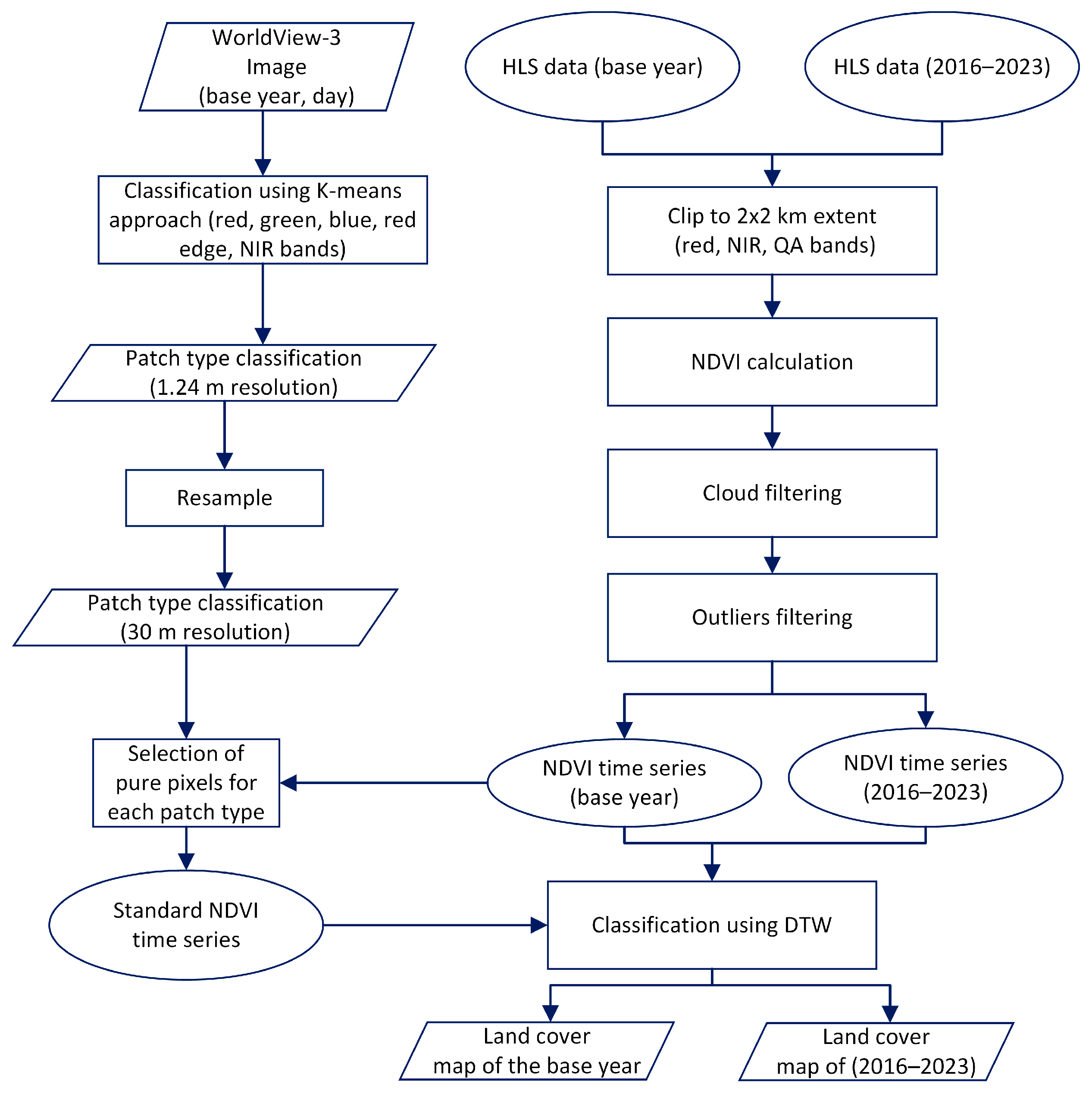
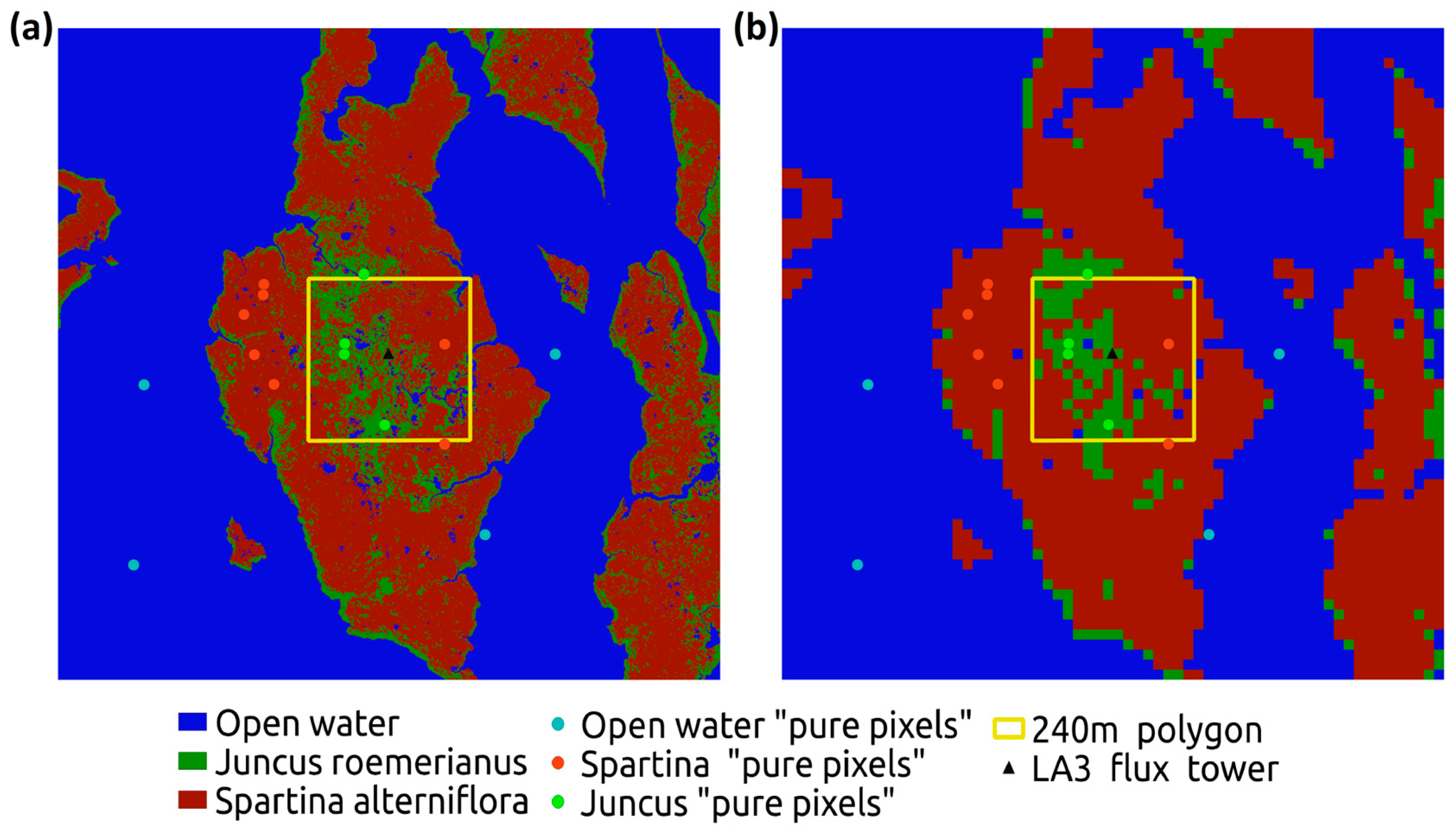
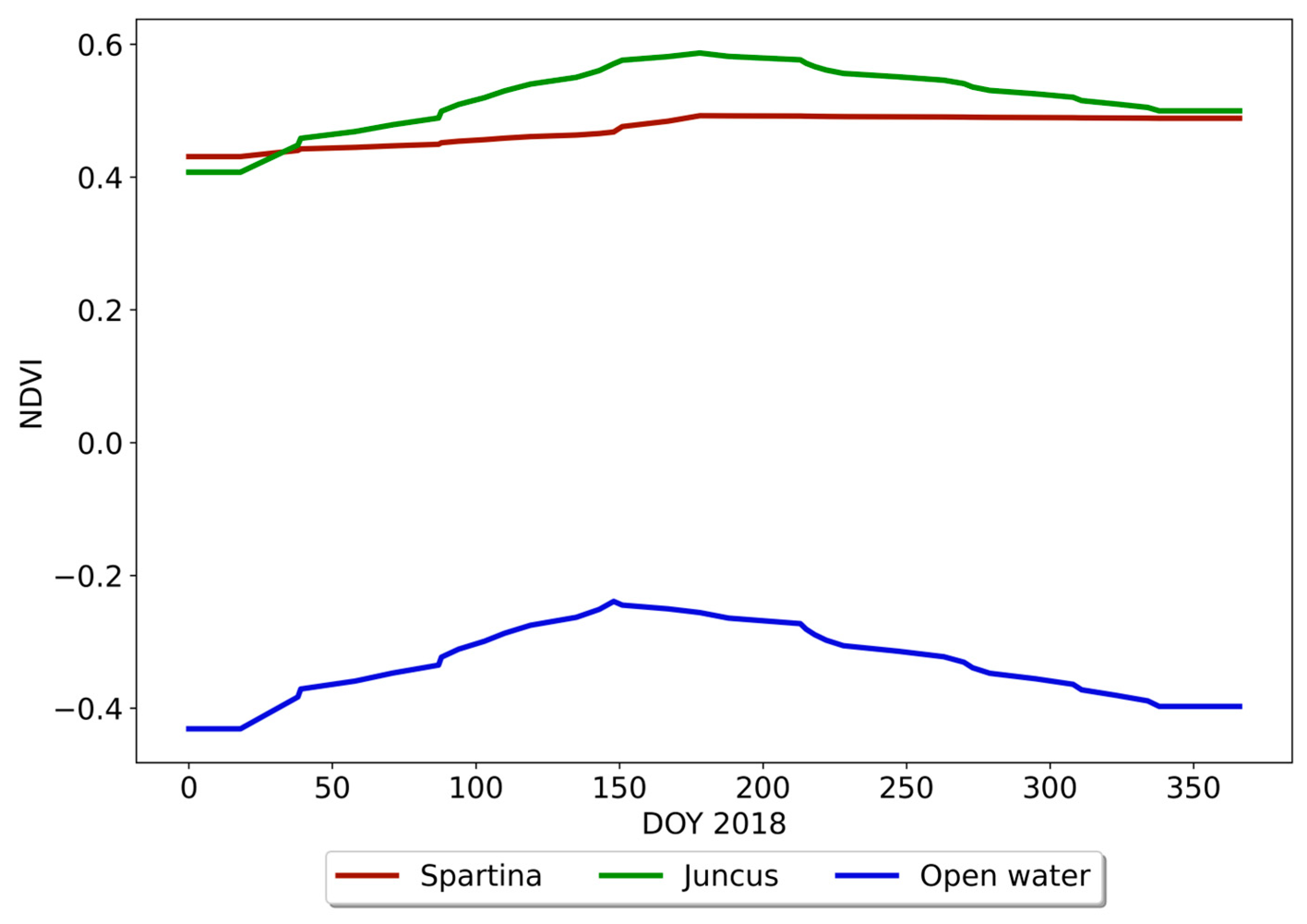
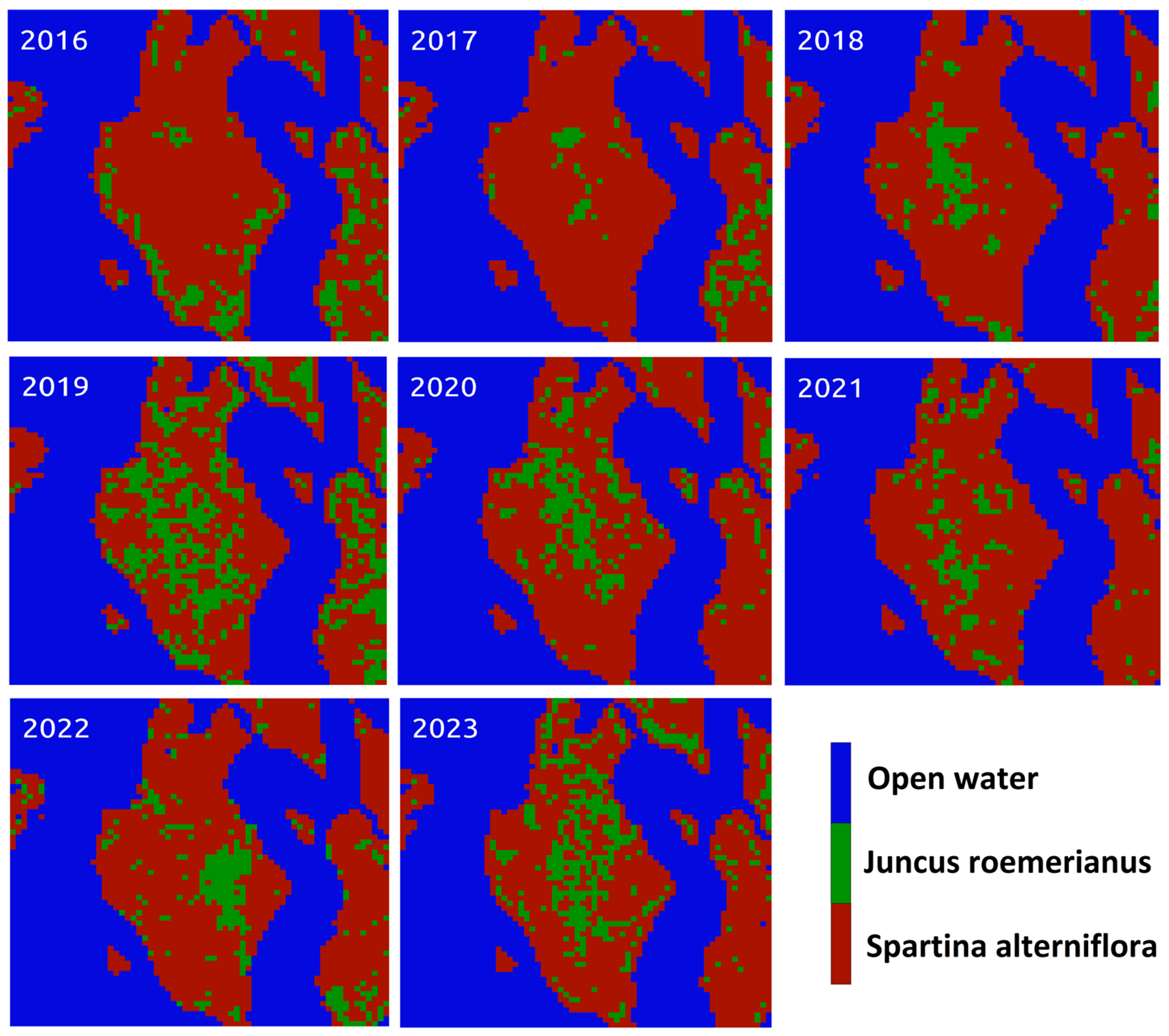
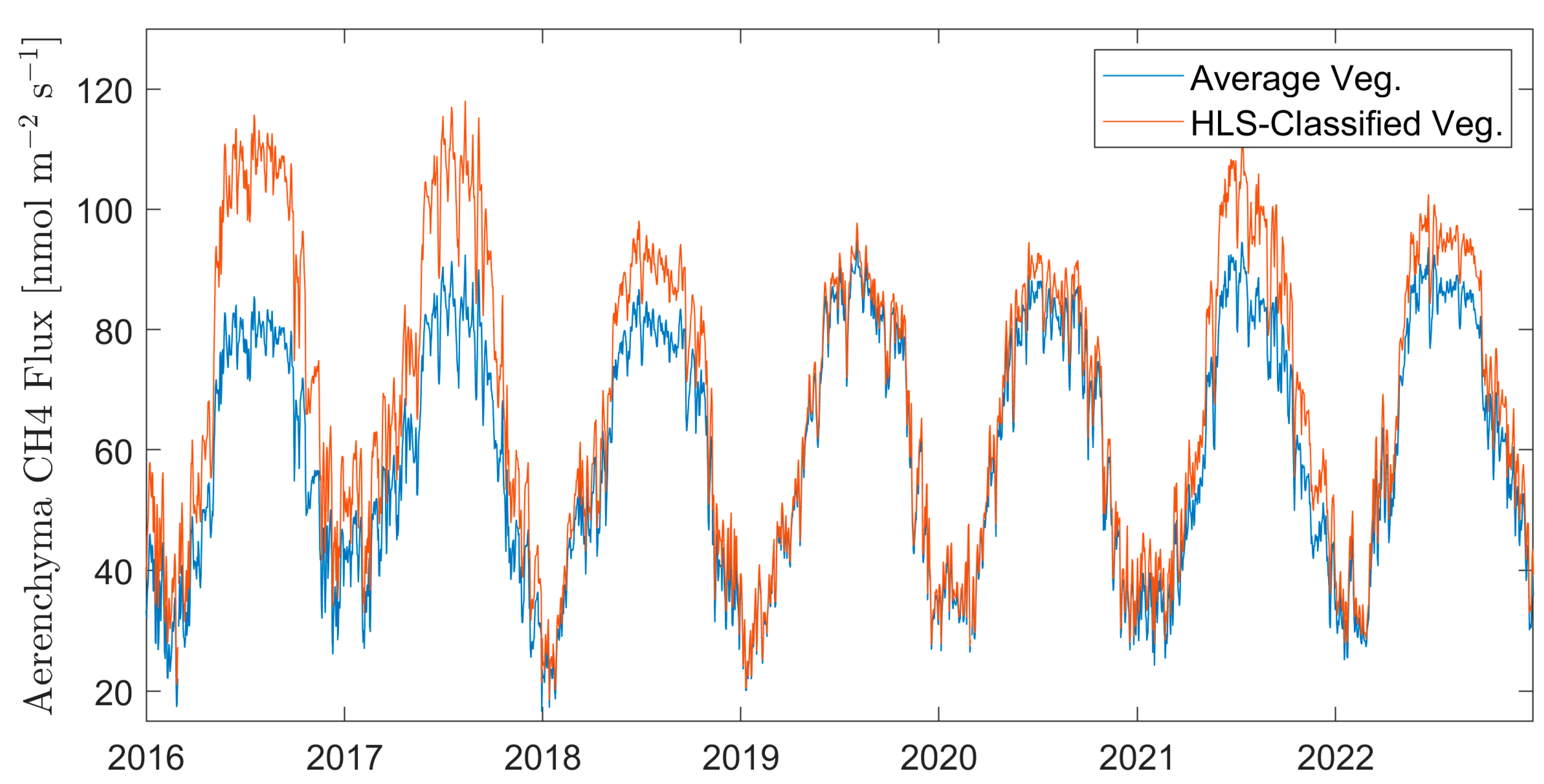
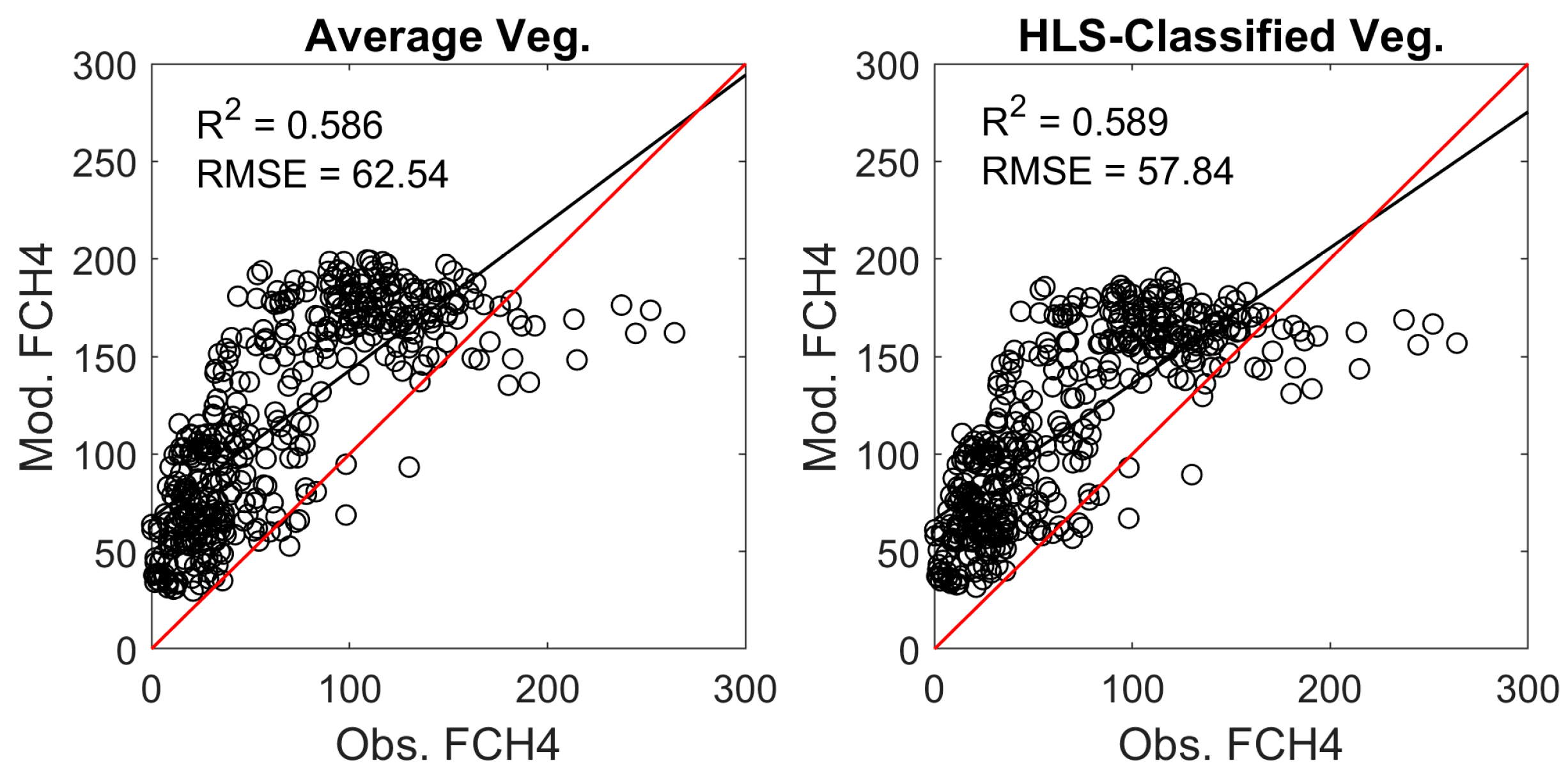
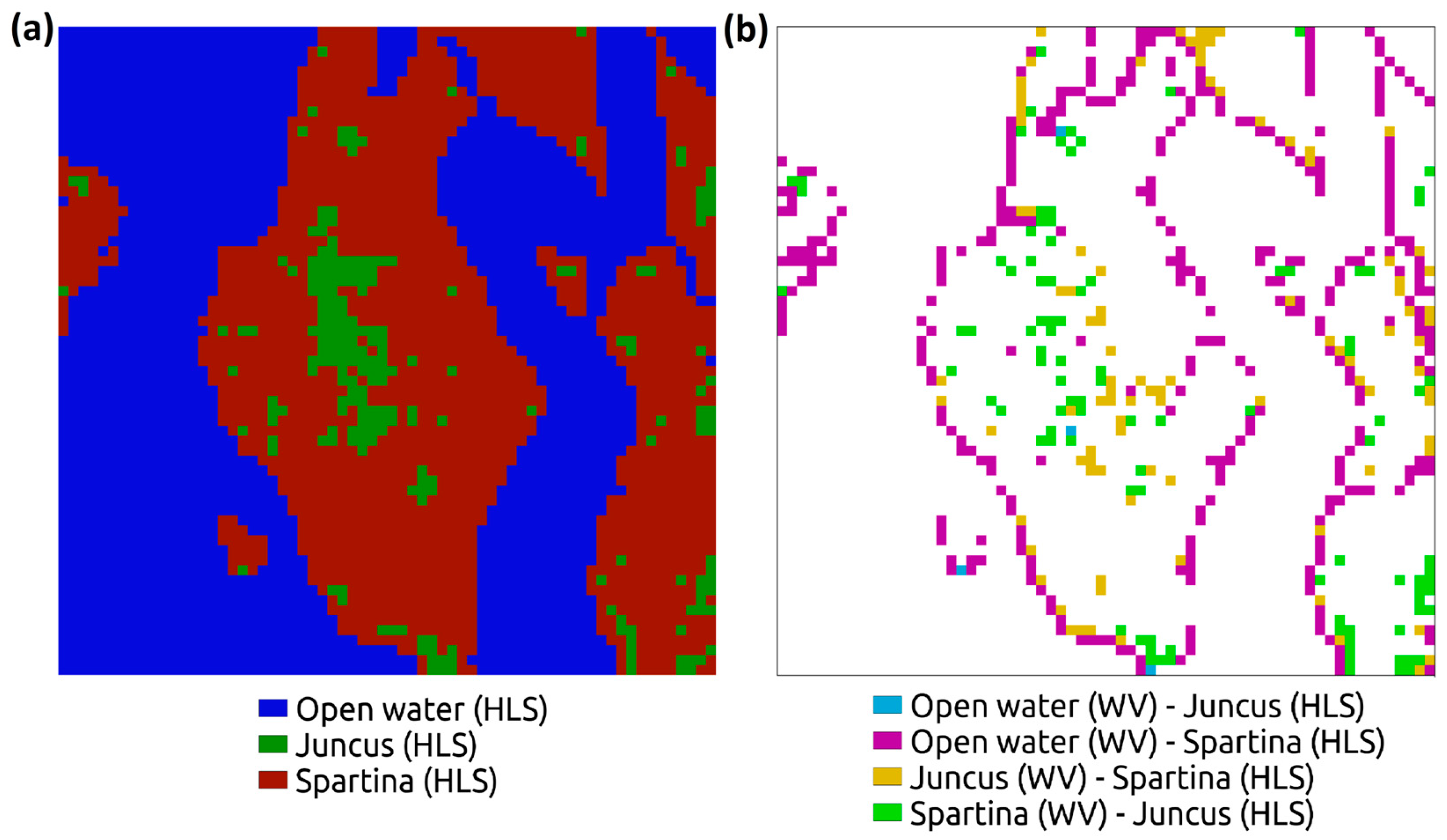
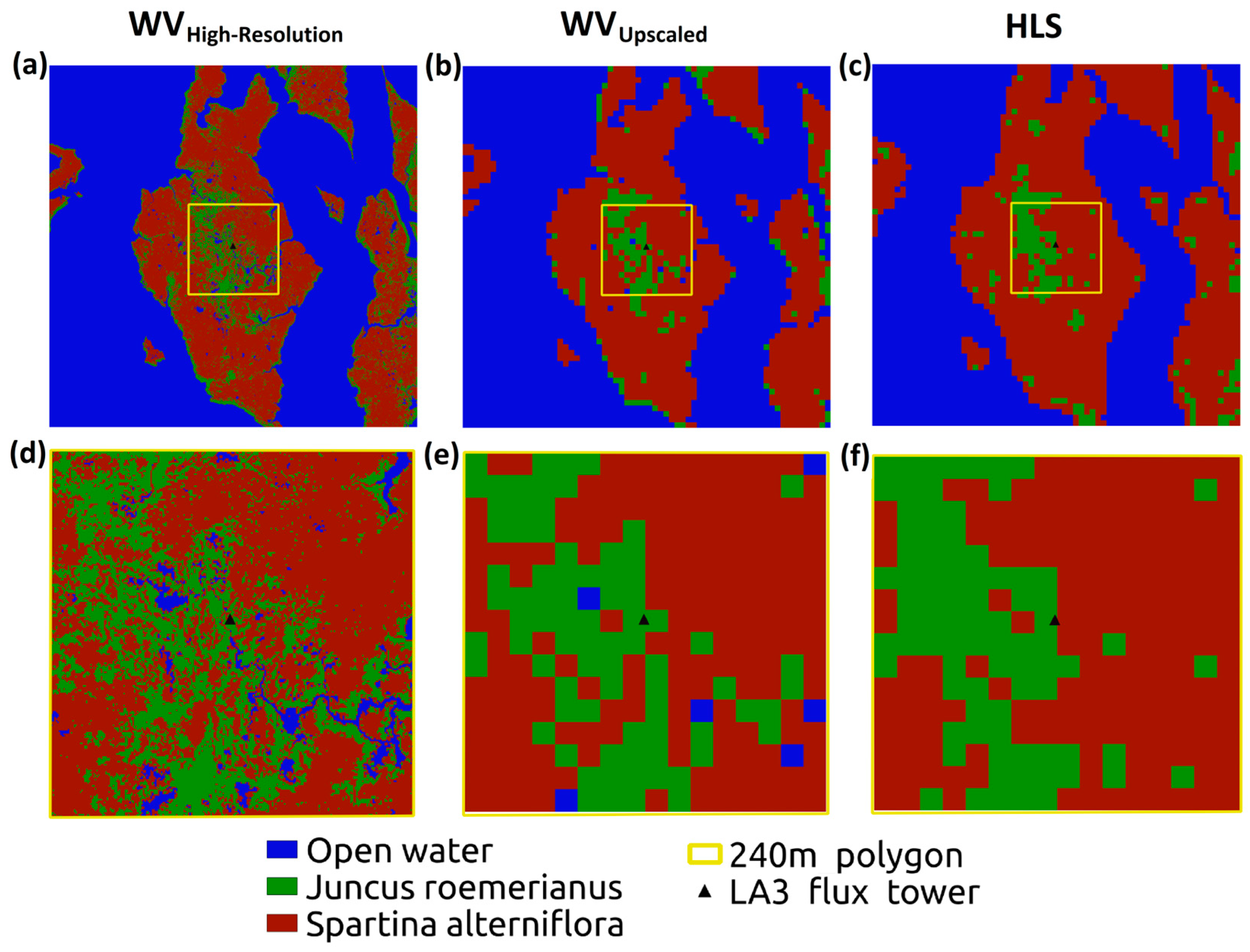
| HLS Classification Patch-Type, Number of Pixels | Total (WorldView-3) | % HLS Pixels Matching WorldView-3 | ||||
|---|---|---|---|---|---|---|
| Open Water | Juncus | Spartina | ||||
| WorldView-3 classification patch-type, number of pixels | Open water | 2178 | 4 | 329 | 2511 | 86.74% |
| Juncus | 0 | 123 | 98 | 221 | 55.66% | |
| Spartina | 0 | 102 | 1456 | 1558 | 93.45% | |
| Total (HLS) | 2178 | 229 | 1883 | |||
| Year | Vegetation | Pixel Count | Percent Cover |
|---|---|---|---|
| 2016 | Juncus | 6 | 2.3 |
| Spartina | 250 | 97.7 | |
| 2017 | Juncus | 32 | 12.5 |
| Spartina | 224 | 87.5 | |
| 2018 | Juncus | 84 | 32.8 |
| Spartina | 172 | 67.2 | |
| 2019 | Juncus | 117 | 45.7 |
| Spartina | 139 | 54.3 | |
| 2020 | Juncus | 108 | 42.2 |
| Spartina | 148 | 57.8 | |
| 2021 | Juncus | 59 | 23.0 |
| Spartina | 197 | 77.0 | |
| 2022 | Juncus | 91 | 35.5 |
| Spartina | 165 | 64.5 | |
| 2023 | Juncus | 109 | 42.6 |
| Spartina | 147 | 57.4 |
| Percent of Pixels (%) | Classification Mismatch Δ (%) | |||||
|---|---|---|---|---|---|---|
| Patch-type | WVHigh-Resolution | WVUpscaled | HLS | Δ (WVUpscaled − WVHigh-Resolution) | Δ (HLS − WVHigh-Resolution) | Δ (HLS − WVUpscaled) |
| Open Water | 4.92 | 2.34 | 0 | −2.58 | −4.92 | −2.34 |
| Juncus | 32.98 | 31.25 | 32.8 | −1.73 | −0.18 | 1.55 |
| Spartina | 62.1 | 66.41 | 67.2 | 4.3 | 5.1 | 0.79 |
Disclaimer/Publisher’s Note: The statements, opinions and data contained in all publications are solely those of the individual author(s) and contributor(s) and not of MDPI and/or the editor(s). MDPI and/or the editor(s) disclaim responsibility for any injury to people or property resulting from any ideas, methods, instructions or products referred to in the content. |
© 2024 by the authors. Licensee MDPI, Basel, Switzerland. This article is an open access article distributed under the terms and conditions of the Creative Commons Attribution (CC BY) license (https://creativecommons.org/licenses/by/4.0/).
Share and Cite
Yazbeck, T.; Bohrer, G.; Shchehlov, O.; Ward, E.; Bordelon, R.; Villa, J.A.; Ju, Y. Integrating NDVI-Based Within-Wetland Vegetation Classification in a Land Surface Model Improves Methane Emission Estimations. Remote Sens. 2024, 16, 946. https://doi.org/10.3390/rs16060946
Yazbeck T, Bohrer G, Shchehlov O, Ward E, Bordelon R, Villa JA, Ju Y. Integrating NDVI-Based Within-Wetland Vegetation Classification in a Land Surface Model Improves Methane Emission Estimations. Remote Sensing. 2024; 16(6):946. https://doi.org/10.3390/rs16060946
Chicago/Turabian StyleYazbeck, Theresia, Gil Bohrer, Oleksandr Shchehlov, Eric Ward, Robert Bordelon, Jorge A. Villa, and Yang Ju. 2024. "Integrating NDVI-Based Within-Wetland Vegetation Classification in a Land Surface Model Improves Methane Emission Estimations" Remote Sensing 16, no. 6: 946. https://doi.org/10.3390/rs16060946
APA StyleYazbeck, T., Bohrer, G., Shchehlov, O., Ward, E., Bordelon, R., Villa, J. A., & Ju, Y. (2024). Integrating NDVI-Based Within-Wetland Vegetation Classification in a Land Surface Model Improves Methane Emission Estimations. Remote Sensing, 16(6), 946. https://doi.org/10.3390/rs16060946







